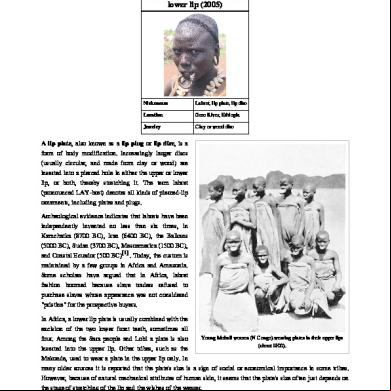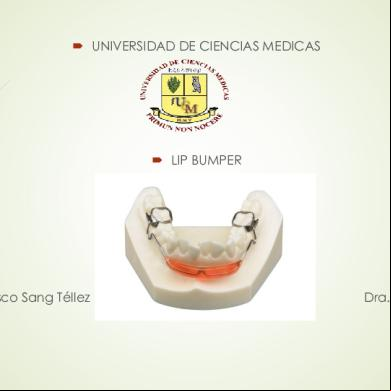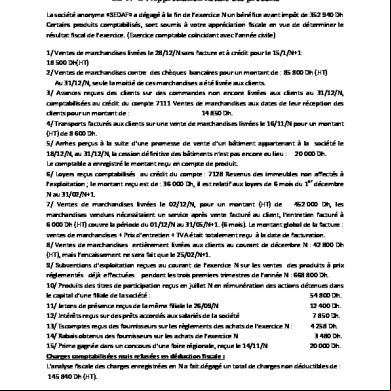Lip Plate 59351z
This document was ed by and they confirmed that they have the permission to share it. If you are author or own the copyright of this book, please report to us by using this report form. Report 3b7i
Overview 3e4r5l
& View Lip Plate as PDF for free.
More details w3441
- Words: 1,422
- Pages: 4
Lip plate
1
Lip plate Mursi woman with stretched lower lip (2005)
Nicknames
Labret, lip plate, lip disc
Location
Omo River, Ethiopia
Jewelry
Clay or wood disc
A lip plate, also known as a lip plug or lip disc, is a form of body modification. Increasingly larger discs (usually circular, and made from clay or wood) are inserted into a pierced hole in either the upper or lower lip, or both, thereby stretching it. The term labret (pronounced LAY-bret) denotes all kinds of pierced-lip ornaments, including plates and plugs. Archeological evidence indicates that labrets have been independently invented no less than six times, in Kamchatka (8700 BC), Iran (6400 BC), the Balkans (5000 BC), Sudan (3700 BC), Mesoamerica (1500 BC), and Coastal Ecuador (500 BC)[1] . Today, the custom is maintained by a few groups in Africa and Amazonia. Some scholars have argued that in Africa, labret fashion boomed because slave traders refused to purchase slaves whose appearance was not considered "pristine" for the prospective buyers. In Africa, a lower lip plate is usually combined with the excision of the two lower front teeth, sometimes all Young Mobali women (N Congo) wearing plates in their upper lips four. Among the Sara people and Lobi a plate is also (about 1900). inserted into the upper lip. Other tribes, such as the Makonde, used to wear a plate in the upper lip only. In many older sources it is reported that the plate's size is a sign of social or economical importance in some tribes. However, because of natural mechanical attributes of human skin, it seems that the plate's size often just depends on the stage of stretching of the lip and the wishes of the wearer. In South America, lip plates are nearly always made from light wood. Among the Surma (own name Suri) and Mursi people of the lower Omo River valley in Ethiopia,[2] about 6 to 12 months before marriage the woman's lip is pierced by her mother or one of her kinswomen, usually at around the age
Lip plate of 15 to 18. The initial piercing is done as an incision of the lower lip of 1 to 2 cm length, and a simple wooden peg is inserted. After the wound has healed, which usually takes 2 or 3 weeks, the peg is replaced with a slightly bigger one. At a diameter of about 4 cm the first lip plate made of clay is inserted. Every woman crafts her plate by herself and takes pride in including some ornamentation. The final diameter ranges from about 8 cm to over 20 cm. (The young woman pictured on p 89 of [3] is wearing a 21–22 cm plate.) Many recent sources (Beckwith and Carter for example)[4] claim that, for Mursi and Surma women, the size of their lip plate indicates the number of cattle paid as the bride price. However anthropologist Turton, who has studied the Mursi for 30 years, denies this.[5] Shauna LaTosky[6] , building from observations and conversations during field research among the Mursi in 2004, discusses in detail why most Mursi women adorn themselves with lip plates and concludes with a narrative that reveals the value of the lip plate within a discourse of female strength and self-esteem. These days, it appears that Mursi girls of age 13 to 18 decide for themselves whether to wear a lip plate or not. The lip plates worn by Mursi and Surma women have been instrumental in making them a popular tourist attraction in recent years, with mixed consequences for these tribes.[7] . In some Amazonian tribes, young men traditionally have their lips pierced when they enter the men's house and leave the world of women.[8] [9] Lip plates there have important associations with oratory and singing, and the largest plates are worn by the greatest orators and war-chiefs, like the well-known environmental campaigner Raoni[10] of the Kayapo tribe. In the Pacific Northwest of North America, among the Haida, Tsimshian, and Tlingit, lip plates used to symbolise social maturity by indicating a girl's eligibility to be a wife. The installation of a girl's first plate was celebrated with a sumptuous feast.[11] Tribes that are known for their traditional lip plates include: • • • • •
The Mursi and Surma (Suri) women of Ethiopia The Suyá men of Brazil (most no longer wear plates) The Sara women of Chad (ceased wearing plates in the 1920s) The Makonde of Tanzania and Mozambique (ceased wearing plates several decades ago) The Botocudo of coastal Brazil (in previous centuries, both sexes wore plates)
Aleut, Inuit and other indigenous peoples of northern Canada, Alaska and surrounding regions also wore large labrets and lip plates; these practices mostly had ceased by the twentieth century. Some tribes (Zo'e in Brazil, Nuba in Sudan, Lobi in west Africa), wear stretched-lip ornaments that are plug- or rod-shaped rather than plate-shaped. In the West, some people, including some of the Modern Primitive movement, have adopted larger-gauge lip piercings, a few large enough for them to wear proper lip plates. Some examples are given on the BME website.[12] [13] [14]
Ubangi misnomer In the late nineteenth and early twentieth centuries, African women wearing lip plates were brought to Europe and North America for exhibit in circuses and sideshows. Around 1930, Ringling Brothers and Barnum & Bailey promoted them as of the Ubangi tribe, but the Ringling press agent itted he picked that name from a map for its exotic sound.[15] Nevertheless, the word Ubangi is still given this definition in English language dictionaries.[16] The word was used in this way in the 1937 Marx Brothers film A Day at the Races.
2
Lip plate
References [1] Grant Keddie: "Symbolism and Context: world history of the labret". Circum-Pacific Prehistory Conference. Seattle, 1989 (http:/ / www. royalbcmuseum. bc. ca/ content_files/ files/ labretw89papersept5-07forweb. pdf) [2] Mursi Online, David Turton's site (http:/ / www. mursi. org) [3] Carol Beckwith and Angela Fisher: "The eloquent Surma". National Geographic 179.2 pp 77-99, 1996 [4] Carol Beckworth and Angela Carter: "African Ark", page 251. Collins Harvill 1990. [5] Mursi Lip-plates (dhebi a tugoin) on Mursi Online (http:/ / www. mursi. org/ life-cycle/ lip-plates) [6] Shauna LaTosky: "Reflections on the lip-plates of Mursi women as a source of stigma and self-esteem". In "Perils of Face: Essays on cultural , respect and self-esteem in southern Ethiopia" pp 382-397, eds. Ivo Strecker and Jean Lydall, Berlin: Lit Verlag 2006. (http:/ / www. mursi. org/ pdf/ latosky. pdf) [7] David Turton: "Lip-plates and 'the people who take photographs': uneasy encounters between Mursi and tourists in southern Ethiopia." Anthropology Today 20.3 pp 3-8, 2004 (http:/ / www. mursi. org/ pdf/ lip-plates. pdf/ view) [8] http:/ / www. socioambiental. org/ pib/ epienglish/ suya/ orn. shtm [9] Anthony Seeger: "The meaning of body ornaments: a Suya example," Ethnology 14(3) pp 211-224, 1975. [10] Raoni - Le combat d'un chef Indien d'Amazonie (http:/ / gertonline. free. fr/ Raoni) [11] Aldona Jonaitis: "Women, Marriage, Mouths and Feasting: the symbolism of Tlingit labrets", pp 191-205 of Arnold Rubin (ed): "Marks of Civilization". Museum of Cultural History, UCLA, 1988 [12] Interviews with two plate-wearers (http:/ / www. bmezine. com/ news/ presenttense/ 20050203. html) [13] Photos of modern scalpelled and other large-gauge lip piercings (http:/ / www. bmezine. com/ pierce/ 05-lips/ scalp001. html) [14] Photos of small lip plates (http:/ / www. bmezine. com/ pierce/ 05-lips/ plate001. html) [15] Joe Nickell: Secrets of the Sideshows, page 189. The University Press of Kentucky. 2005. (http:/ / books. google. com/ books?id=sACcmMWM6t4C& lpg=PA189& dq=Ubangi& pg=PA189#v=onepage& q=Ubangi& f=false) [16] "Ubangi." Dictionary.com Unabridged. Random House, Inc. 11 Nov. 2009. Merriam-Webster Online. 11 November 2009 (http:/ / dictionary. reference. com/ browse/ Ubangi).
External links • Youtube video showing Sara Kaba women with the double lip plates they used to wear (http://www.youtube. com/watch?v=Bkiua38BN2I&feature=related) • flickr: Surma and Mursi maxi-lips (http://www.flickr.com/groups/1519843@N21/) • Youtube video showing Sara women (http://www.youtube.com/watch?v=oU5UzMaMcTc)
3
Article Sources and Contributors
Article Sources and Contributors Lip plate Source: http://en.wikipedia.org/w/index.php?oldid=439125369 Contributors: AgentPeppermint, Angelo De La Paz, Babbage, Belovedfreak, Bobo192, Caltas, CambridgeBayWeather, Chubbles, CommonsDelinker, DanielCD, Darwinek, Delfedd, Diza, Duckblurquackster, Emijrp, Est.r, Fightindaman, Gilliam, Haabet, Hmwith, JaGa, Jashiin, Jim10701, Johannes Rohr, Johnacko, Lady alys, Mr.tougas, Nono64, OGOL, Orioane, Oxonhutch, Oxymoron83, Pete unseth, RazorICE, Schneelocke, Slowtiger, Switchercat, TurtleMelody, Ukexpat, Wiki-uk, Woohookitty, Yom, Шизомби, 47 anonymous edits
Image Sources, Licenses and Contributors Image:Mursi woman.jpg Source: http://en.wikipedia.org/w/index.php?title=File:Mursi_woman.jpg License: Creative Commons Attribution 2.0 Contributors: Monkeyji Image:Mobaliweiber mit lippenpflock nordkongo.jpg Source: http://en.wikipedia.org/w/index.php?title=File:Mobaliweiber_mit_lippenpflock_nordkongo.jpg License: Public Domain Contributors: Haabet, Warden
License Creative Commons Attribution-Share Alike 3.0 Unported http:/ / creativecommons. org/ licenses/ by-sa/ 3. 0/
4
1
Lip plate Mursi woman with stretched lower lip (2005)
Nicknames
Labret, lip plate, lip disc
Location
Omo River, Ethiopia
Jewelry
Clay or wood disc
A lip plate, also known as a lip plug or lip disc, is a form of body modification. Increasingly larger discs (usually circular, and made from clay or wood) are inserted into a pierced hole in either the upper or lower lip, or both, thereby stretching it. The term labret (pronounced LAY-bret) denotes all kinds of pierced-lip ornaments, including plates and plugs. Archeological evidence indicates that labrets have been independently invented no less than six times, in Kamchatka (8700 BC), Iran (6400 BC), the Balkans (5000 BC), Sudan (3700 BC), Mesoamerica (1500 BC), and Coastal Ecuador (500 BC)[1] . Today, the custom is maintained by a few groups in Africa and Amazonia. Some scholars have argued that in Africa, labret fashion boomed because slave traders refused to purchase slaves whose appearance was not considered "pristine" for the prospective buyers. In Africa, a lower lip plate is usually combined with the excision of the two lower front teeth, sometimes all Young Mobali women (N Congo) wearing plates in their upper lips four. Among the Sara people and Lobi a plate is also (about 1900). inserted into the upper lip. Other tribes, such as the Makonde, used to wear a plate in the upper lip only. In many older sources it is reported that the plate's size is a sign of social or economical importance in some tribes. However, because of natural mechanical attributes of human skin, it seems that the plate's size often just depends on the stage of stretching of the lip and the wishes of the wearer. In South America, lip plates are nearly always made from light wood. Among the Surma (own name Suri) and Mursi people of the lower Omo River valley in Ethiopia,[2] about 6 to 12 months before marriage the woman's lip is pierced by her mother or one of her kinswomen, usually at around the age
Lip plate of 15 to 18. The initial piercing is done as an incision of the lower lip of 1 to 2 cm length, and a simple wooden peg is inserted. After the wound has healed, which usually takes 2 or 3 weeks, the peg is replaced with a slightly bigger one. At a diameter of about 4 cm the first lip plate made of clay is inserted. Every woman crafts her plate by herself and takes pride in including some ornamentation. The final diameter ranges from about 8 cm to over 20 cm. (The young woman pictured on p 89 of [3] is wearing a 21–22 cm plate.) Many recent sources (Beckwith and Carter for example)[4] claim that, for Mursi and Surma women, the size of their lip plate indicates the number of cattle paid as the bride price. However anthropologist Turton, who has studied the Mursi for 30 years, denies this.[5] Shauna LaTosky[6] , building from observations and conversations during field research among the Mursi in 2004, discusses in detail why most Mursi women adorn themselves with lip plates and concludes with a narrative that reveals the value of the lip plate within a discourse of female strength and self-esteem. These days, it appears that Mursi girls of age 13 to 18 decide for themselves whether to wear a lip plate or not. The lip plates worn by Mursi and Surma women have been instrumental in making them a popular tourist attraction in recent years, with mixed consequences for these tribes.[7] . In some Amazonian tribes, young men traditionally have their lips pierced when they enter the men's house and leave the world of women.[8] [9] Lip plates there have important associations with oratory and singing, and the largest plates are worn by the greatest orators and war-chiefs, like the well-known environmental campaigner Raoni[10] of the Kayapo tribe. In the Pacific Northwest of North America, among the Haida, Tsimshian, and Tlingit, lip plates used to symbolise social maturity by indicating a girl's eligibility to be a wife. The installation of a girl's first plate was celebrated with a sumptuous feast.[11] Tribes that are known for their traditional lip plates include: • • • • •
The Mursi and Surma (Suri) women of Ethiopia The Suyá men of Brazil (most no longer wear plates) The Sara women of Chad (ceased wearing plates in the 1920s) The Makonde of Tanzania and Mozambique (ceased wearing plates several decades ago) The Botocudo of coastal Brazil (in previous centuries, both sexes wore plates)
Aleut, Inuit and other indigenous peoples of northern Canada, Alaska and surrounding regions also wore large labrets and lip plates; these practices mostly had ceased by the twentieth century. Some tribes (Zo'e in Brazil, Nuba in Sudan, Lobi in west Africa), wear stretched-lip ornaments that are plug- or rod-shaped rather than plate-shaped. In the West, some people, including some of the Modern Primitive movement, have adopted larger-gauge lip piercings, a few large enough for them to wear proper lip plates. Some examples are given on the BME website.[12] [13] [14]
Ubangi misnomer In the late nineteenth and early twentieth centuries, African women wearing lip plates were brought to Europe and North America for exhibit in circuses and sideshows. Around 1930, Ringling Brothers and Barnum & Bailey promoted them as of the Ubangi tribe, but the Ringling press agent itted he picked that name from a map for its exotic sound.[15] Nevertheless, the word Ubangi is still given this definition in English language dictionaries.[16] The word was used in this way in the 1937 Marx Brothers film A Day at the Races.
2
Lip plate
References [1] Grant Keddie: "Symbolism and Context: world history of the labret". Circum-Pacific Prehistory Conference. Seattle, 1989 (http:/ / www. royalbcmuseum. bc. ca/ content_files/ files/ labretw89papersept5-07forweb. pdf) [2] Mursi Online, David Turton's site (http:/ / www. mursi. org) [3] Carol Beckwith and Angela Fisher: "The eloquent Surma". National Geographic 179.2 pp 77-99, 1996 [4] Carol Beckworth and Angela Carter: "African Ark", page 251. Collins Harvill 1990. [5] Mursi Lip-plates (dhebi a tugoin) on Mursi Online (http:/ / www. mursi. org/ life-cycle/ lip-plates) [6] Shauna LaTosky: "Reflections on the lip-plates of Mursi women as a source of stigma and self-esteem". In "Perils of Face: Essays on cultural , respect and self-esteem in southern Ethiopia" pp 382-397, eds. Ivo Strecker and Jean Lydall, Berlin: Lit Verlag 2006. (http:/ / www. mursi. org/ pdf/ latosky. pdf) [7] David Turton: "Lip-plates and 'the people who take photographs': uneasy encounters between Mursi and tourists in southern Ethiopia." Anthropology Today 20.3 pp 3-8, 2004 (http:/ / www. mursi. org/ pdf/ lip-plates. pdf/ view) [8] http:/ / www. socioambiental. org/ pib/ epienglish/ suya/ orn. shtm [9] Anthony Seeger: "The meaning of body ornaments: a Suya example," Ethnology 14(3) pp 211-224, 1975. [10] Raoni - Le combat d'un chef Indien d'Amazonie (http:/ / gertonline. free. fr/ Raoni) [11] Aldona Jonaitis: "Women, Marriage, Mouths and Feasting: the symbolism of Tlingit labrets", pp 191-205 of Arnold Rubin (ed): "Marks of Civilization". Museum of Cultural History, UCLA, 1988 [12] Interviews with two plate-wearers (http:/ / www. bmezine. com/ news/ presenttense/ 20050203. html) [13] Photos of modern scalpelled and other large-gauge lip piercings (http:/ / www. bmezine. com/ pierce/ 05-lips/ scalp001. html) [14] Photos of small lip plates (http:/ / www. bmezine. com/ pierce/ 05-lips/ plate001. html) [15] Joe Nickell: Secrets of the Sideshows, page 189. The University Press of Kentucky. 2005. (http:/ / books. google. com/ books?id=sACcmMWM6t4C& lpg=PA189& dq=Ubangi& pg=PA189#v=onepage& q=Ubangi& f=false) [16] "Ubangi." Dictionary.com Unabridged. Random House, Inc. 11 Nov. 2009. Merriam-Webster Online. 11 November 2009 (http:/ / dictionary. reference. com/ browse/ Ubangi).
External links • Youtube video showing Sara Kaba women with the double lip plates they used to wear (http://www.youtube. com/watch?v=Bkiua38BN2I&feature=related) • flickr: Surma and Mursi maxi-lips (http://www.flickr.com/groups/1519843@N21/) • Youtube video showing Sara women (http://www.youtube.com/watch?v=oU5UzMaMcTc)
3
Article Sources and Contributors
Article Sources and Contributors Lip plate Source: http://en.wikipedia.org/w/index.php?oldid=439125369 Contributors: AgentPeppermint, Angelo De La Paz, Babbage, Belovedfreak, Bobo192, Caltas, CambridgeBayWeather, Chubbles, CommonsDelinker, DanielCD, Darwinek, Delfedd, Diza, Duckblurquackster, Emijrp, Est.r, Fightindaman, Gilliam, Haabet, Hmwith, JaGa, Jashiin, Jim10701, Johannes Rohr, Johnacko, Lady alys, Mr.tougas, Nono64, OGOL, Orioane, Oxonhutch, Oxymoron83, Pete unseth, RazorICE, Schneelocke, Slowtiger, Switchercat, TurtleMelody, Ukexpat, Wiki-uk, Woohookitty, Yom, Шизомби, 47 anonymous edits
Image Sources, Licenses and Contributors Image:Mursi woman.jpg Source: http://en.wikipedia.org/w/index.php?title=File:Mursi_woman.jpg License: Creative Commons Attribution 2.0 Contributors: Monkeyji Image:Mobaliweiber mit lippenpflock nordkongo.jpg Source: http://en.wikipedia.org/w/index.php?title=File:Mobaliweiber_mit_lippenpflock_nordkongo.jpg License: Public Domain Contributors: Haabet, Warden
License Creative Commons Attribution-Share Alike 3.0 Unported http:/ / creativecommons. org/ licenses/ by-sa/ 3. 0/
4










